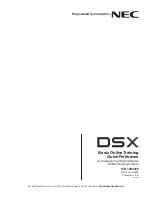
Greeting
Description
A Subscriber Mailbox user can record a personalized greeting for his mailbox. After the greeting is
recorded, callers hear a prerecorded personalized greeting rather than a default message.
The recorded message can include the following:
• Subscriber name
• Personal message (such as "Hello - I am on vacation this week")
• Instructions on leaving a message or using other mailbox options
• Next Call Routing Mailbox options, if available
While listening to a mailbox greeting, a caller can dial
*
to immediately skip the message.
Remote Greetings
A Subscriber Mailbox user can call into the Automated Attendant, access their mailbox, and remotely
record their mailbox greeting.
Following are two of the ways a user can do this:
• After the Automated Attendant answers, dial a digit (typically
#
) followed by their mailbox number.
This method allows outside callers to log into their Subscriber Mailboxes from outside the company.
After logging on to their mailbox, the user can dial G to record a greeting.
• If an extension has a Direct Inward Line that is forwarded to voice mail, the caller can dial
#
and log
on to their mailbox (instead of leaving a message). After they log on to their mailbox, the user can
dial G to record a greeting. This option must be set up in the Next Call Routing Mailbox. To allow
this ability, for example:
- Program the Next Call Routing Mailbox # digit as LOGON to IXXX.
- While listening to their greeting, the subscriber can dial:
#
(to route to their Next Call Routing Mailbox), then
#
and their mailbox number to log on to their mailbox.
- By default, this option is provided in Call Routing Mailbox 1. Additionally, the subscriber should
enable a Security Code for their mailbox to prevent unauthorized logons.
Multiple Greetings
In systems with Multiple Greetings, the mailbox subscriber can record up to three separate greetings
and make any one of the three active. When a caller leaves a message in the subscriber's mailbox,
they hear the active greeting. This allows the subscriber, for example, to record separate greetings for
work hours, after work, and during vacation. Instead of revising the recording when they leave the
office, they can activate the after work greeting instead.
If an active greeting is not recorded, a caller hears, "At the tone, you can leave your message for
(extension number or name)."
Related Features
Auto Attendant Direct to Voice Mail on page 2-26
SL1100
ISSUE 3.5
2-110
Greeting
G
Summary of Contents for SL1100
Page 1: ...InMail Feature Manual A50 031762 003 NA ISSUE 3 5...
Page 8: ...MEMO SL1100 ISSUE 3 5 vi InMail Feature Manual...
Page 18: ...MEMO SL1100 ISSUE 3 5 1 10 Quick Setup...
Page 196: ...Operation Not applicable SL1100 ISSUE 3 5 2 178 Message Length M...
Page 207: ...Message Reply 0 Plays Help message ISSUE 3 5 SL1100 InMail Feature Manual 2 189 M...
Page 216: ...Operation Not applicable SL1100 ISSUE 3 5 2 198 Next Call Routing Mailbox N...
Page 251: ...Operation Not applicable ISSUE 3 5 SL1100 InMail Feature Manual 2 233 S...
Page 282: ...MEMO SL1100 ISSUE 3 5 3 14 InMail Utility...
Page 286: ...MEMO SL1100 ISSUE 3 5 4 4 Soft Key Glossary...
Page 287: ...MEMO ISSUE 3 5 SL1100 InMail Feature Manual 4 5...
Page 288: ...InMail Feature Manual NEC Corporation ISSUE 3 5...















































